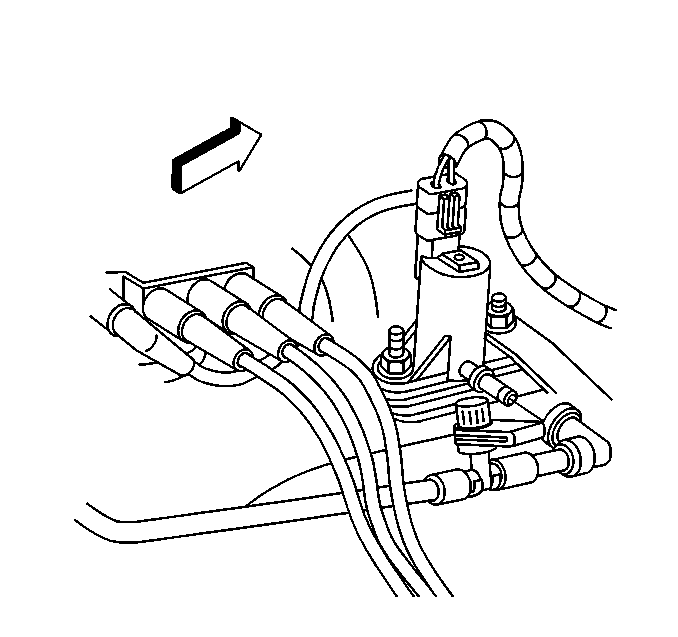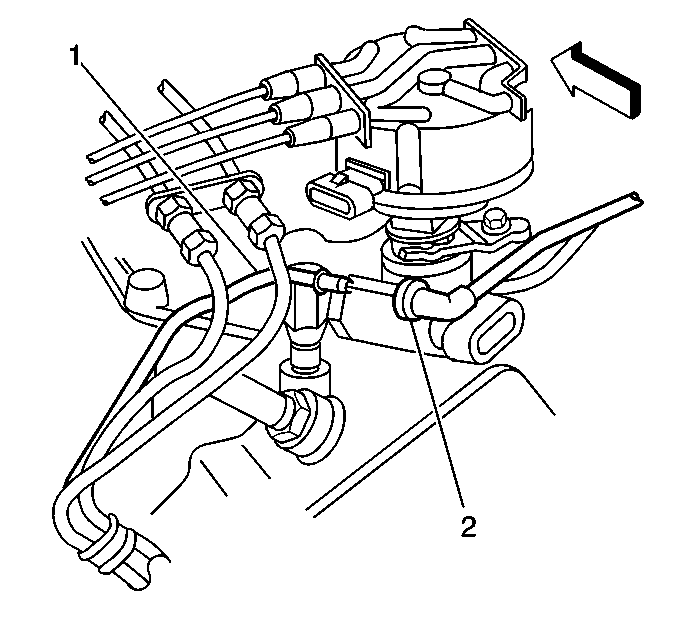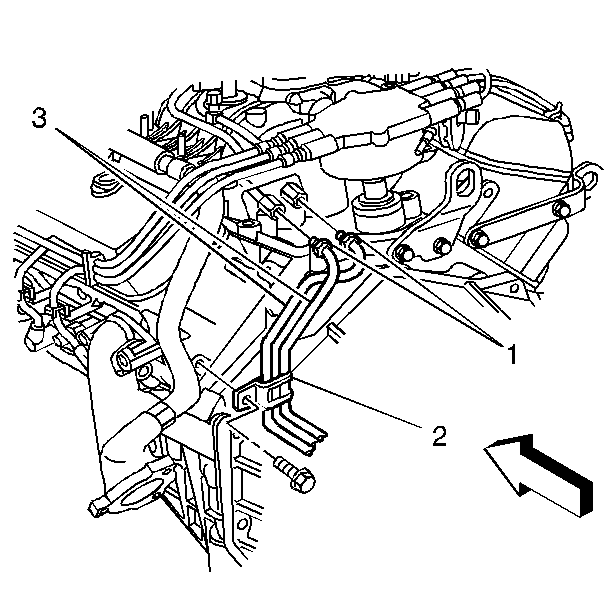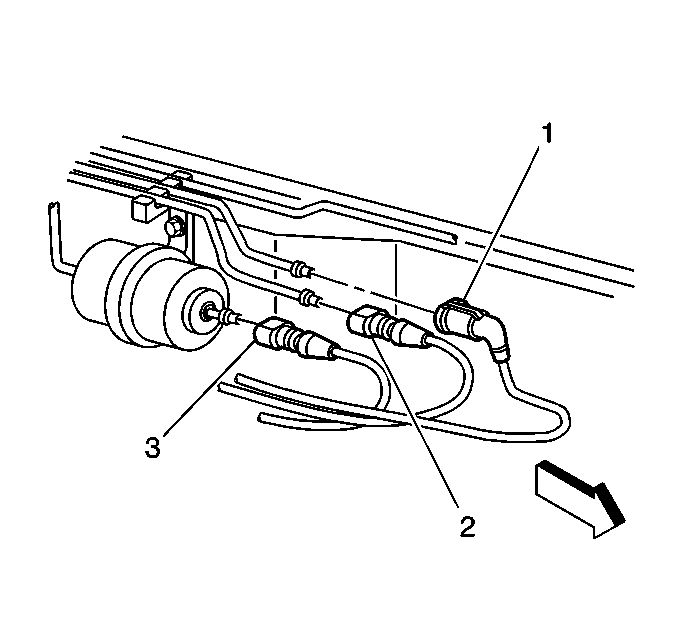Evaporative Emission System Hoses/Pipes Replacement Engine
Removal Procedure

- Disconnect the EVAP pipe
from the EVAP purge solenoid. Refer to
Plastic Collar Quick Connect Fitting Service
.

- Disconnect the EVAP (2)
pipe from the EVAP front chassis pipe (1). Refer to
Plastic Collar Quick Connect Fitting Service
.
Installation Procedure

- Connect the EVAP pipe
(2) to the EVAP front chassis pipe (1). Refer to
Plastic Collar Quick Connect Fitting Service
.

- Connect the EVAP pipe
to the EVAP purge solenoid. Refer to
Plastic Collar Quick Connect Fitting Service
.
Evaporative Emission System Hoses/Pipes Replacement Chassis
Removal Procedure

Caution: Unless directed otherwise, the ignition and start switch must be in the OFF or LOCK position, and all electrical loads must be OFF before servicing
any electrical component. Disconnect the negative battery cable to prevent an electrical spark should a tool or equipment come in contact with an exposed electrical terminal. Failure to follow these precautions may result in personal injury and/or damage to
the vehicle or its components.
- Disconnect the negative battery cable.
- Relieve the fuel system pressure. Refer to
Fuel Pressure Relief
.
- Disconnect the chassis EVAP, fuel feed and return pipes (1) at the engine compartment EVAP, fuel feed and return pipes.
- Remove the transmission. Refer to
Transmission Replacement
or
Transmission Replacement
or
Transmission Replacement
.
- Remove the EVAP/fuel pipe retainer clip (2) from the left cylinder head.

- Disconnect the EVAP pipe (1). Refer to
Plastic Collar Quick Connect Fitting Service
.
- Remove the EVAP pipe from the retainers.
Installation Procedure
Caution: In order to reduce the risk of fire and personal injury, before connecting
fuel pipe fittings, always apply a few drops of clean engine oil to the male
pipe ends.
This will ensure proper reconnection and prevent a possible fuel leak.
During normal operation, the O-rings located in the female connector
will swell and may prevent proper reconnection if not lubricated.

- Install the new O-ring seals on the engine compartment EVAP, fuel feed and the return pipes.
- Connect the chassis EVAP, fuel feed and return pipes (1) to the engine compartment fuel feed and return pipes.
Notice: Use the correct fastener in the correct location. Replacement fasteners
must be the correct part number for that application. Fasteners requiring
replacement or fasteners requiring the use of thread locking compound or sealant
are identified in the service procedure. Do not use paints, lubricants, or
corrosion inhibitors on fasteners or fastener joint surfaces unless specified.
These coatings affect fastener torque and joint clamping force and may damage
the fastener. Use the correct tightening sequence and specifications when
installing fasteners in order to avoid damage to parts and systems.
- Install the EVAP and fuel pipes into the retainer clip (2).
- Install the retainer clip bolt.
Tighten
Tighten the fuel pipe retainer clip bolt to 30 N·m (22 lb ft).

- Connect the EVAP pipe. Refer to
Plastic Collar Quick Connect Fitting Service
.
- Install the transmission. Refer to
Transmission Replacement
or
Transmission Replacement
or
Transmission Replacement
.
- Tighten the fuel filler cap.
- Connect the negative battery cable.
- Inspect for leaks.
| 9.1. | Turn ON the ignition switch for 2 seconds. |
| 9.2. | Turn OFF the ignition switch for 10 seconds. |
| 9.3. | Turn ON the ignition switch. |
| 9.4. | Inspect for fuel leaks. |
Evaporative Emission System Hoses/Pipes Replacement Rear
Removal Procedure
Tool Required
J 34730-1A Fuel Pressure Gauge

Caution: Unless directed otherwise, the ignition and start switch must be in the OFF or LOCK position, and all electrical loads must be OFF before servicing
any electrical component. Disconnect the negative battery cable to prevent an electrical spark should a tool or equipment come in contact with an exposed electrical terminal. Failure to follow these precautions may result in personal injury and/or damage to
the vehicle or its components.
- Disconnect the negative battery cable.
- Relieve the fuel system pressure. Refer to the
Fuel Pressure Relief
.
- Drain the fuel tank. Refer to
Fuel Tank Draining
.
- Raise the vehicle. Refer to
Lifting and Jacking the Vehicle
in General Information.
- Clean all the fuel and EVAP pipe connections and the surrounding areas before disconnecting in order to avoid possible contamination of the fuel system.
- Remove the fuel tank. Refer to
Fuel Tank Replacement
.
- Disconnect the rear EVAP pipe from the chassis EVAP pipe (1).
- Remove the EVAP pipe from the retainers.
- Cap the fuel and EVAP pipes in order to prevent possible fuel system contamination.
Installation Procedure

- Remove the caps from the fuel and EVAP pipes.
- Connect the rear EVAP pipe to the chassis EVAP pipe (1).
- Install the EVAP pipe into the retainers.
- Install the fuel tank. Refer to
Fuel Tank Replacement
.
- Lower the vehicle.
- Refill the fuel tank.
- Tighten the fuel filler cap.
- Connect the negative battery cable.
- Inspect for leaks.
| 9.1. | Turn the ignition switch ON for 2 seconds. |
| 9.2. | Turn the ignition switch OFF for 10 seconds. |
| 9.3. | Turn the ignition switch ON. |
| 9.4. | Inspect for fuel leaks. |










